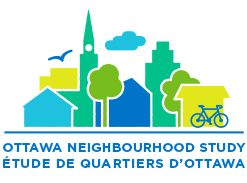About Neighbourhood Boundaries
In many studies, “neighbourhoods” are often described as political, administrative or statistical units that are the result of imposing geographic divisions of convenience on geographic space (consider, for example, census tracts, dissemination polygons, postal codes, municipal wards, etc). The Ottawa Neighbourhood Study (ONS) uses a different approach to delineate “natural” neighbourhood units that include residents’ perceptions of the communities in which they live, work, play and raise their families:
- a functional approach: using Statistics Canada data ONS selects relevant socioeconomic and demographic variables from the census. These are used as inputs to spatially constrained cluster analysis to create proto-neighbourhoods that are not only similar in multidimensional space but also adjacent to each other within geographic space; and
- a physical approach: environmental elements that act as natural barriers (e.g. railways, arterial roadways, waterways, bridge crossings, hydro easements, etc.) are overlaid on the proto-neighbourhoods derived from the functional approach and boundaries are adjusted accordingly. The resulting natural boundaries for a proto-neighbourhood may follow, in whole or part, a dissemination area (DA) boundary and/or some other ostensible feature, natural or imposed; and
- a participatory research framework whereby residents are invited to provide feedback and recommendations about the proto-neighbourhood boundaries based on the economic, social or health-related processes that take place within and between them. This is the final step to modifying the boundaries of proto-neighborhoods and producing ONS natural neighbourhoods.
In rural areas of the City of Ottawa, where populations are smaller and often dispersed over a larger areas, ONS uses:
- dasymetric mapping to approximate the true geographic distribution of the population, irrespective of natural neighbourhood or administrative boundaries, and to derive geographic weights for the purposes of improving estimates of social, environmental and health based data within ONS natural neighbourhoods, both rural and urban.
- spatial microsimulation techniques that allow the characteristics of individuals living in particular neighbourhoods with smaller populations or very few health outcomes to be approximated, based upon constraint variables known about the area.
The above approach delineates natural neighbourhoods using data from DMTI Spatial Inc., Statistics Canada, the City of Ottawa, the National Capital Commission, the Ottawa Real Estate Board, Digital Globe satellite imagery, field-based observations, and expert and community knowledge.
It is not uncommon for several distinct communities to be included in a single ONS natural neighbourhood. Because reliable estimates for many measures require medium-large population counts, smaller communities cannot be described separately by the ONS. To avoid data suppression and to help stabilize rate calculations, ONS tries to maintain a minimum population of 4,000 residents to define neighbourhoods.
Unfortunately, when small communities are included within larger natural neighbourhoods their unique character may be lost. This is a shortcoming of studies of this kind. Those who are using the ONS to help inform their planning decisions need to understand that the neighbourhoods described here may hide the unique strengths and challenges of some distinct communities within them. The ONS should be regarded as only one source of information; other sources that help identify these variations also need to be considered as part of any decision-making process.
ONS reviews and revises neighbourhood boundaries every ten years (reflecting two full census cycles). Over time, populations may grow or shrink, imposed environmental elements may evolve, residents’ perceptions of neighbourhoods may change, and/or there may be changes to the social, economic or health-related processes taking place within the boundaries. Revised boundaries make trend analysis challenging; any changes to a neighbourhood boundary necessitates corresponding changes not only to the boundaries of adjacent neighbourhoods but also changes to the data that describes the neighbourhoods impacted.
Any users that wish to reclassify an area into a different neighbourhood should view their area along with some of the data that was used to generate the ONS boundaries (dissemination areas, natural features, etc.) to understand how the natural boundaries were initially derived. Users can contact the ONS study lead directly by using this form.
______________________________________________________________
[ONS has described its methodology to derive natural neighbourhood boundaries in these academic papers:
- Parenteau Marie-Pierre, M. Sawada, E. Kristjansson, et al. 2008. Development of neighbourhoods to measure spatial indicators of health. Journal of the Urban and Regional Information Systems Association, 20(2): 43-55
- Mosley Brian & M. Sawada 2012. Estimating health determinants and outcomes in rural Ottawa: An integration of geographic and statistical techniques. University of Ottawa: unpublished]
